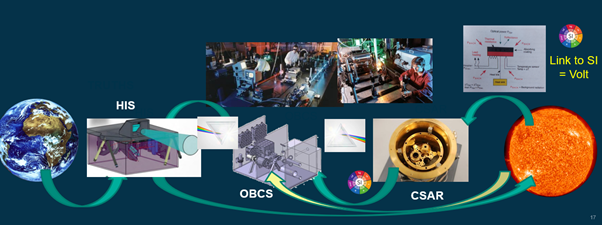
Instrument degradation over the lifetime of a satellite mission requires an independent means to monitor and correct calibration changes to ensure Earth Observation (EO) data records remain fit for purpose. The TRUTHS mission is unique in establishing SI-traceable measurements of unequivocal accuracy in-flight using its novel Onboard Calibration System (OBCS), in effect realising a ‘metrology laboratory in space'.
The heart of the TRUTHS calibration capability is the primary SI standard, the Cryogenic Solar Absolute Radiometer (CSAR), which is a flight version of the cryogenic radiometer. The CSAR and a transfer scheme (see video/diagram) performed by the OBCS largely mimic methods used on the ground at metrology institutes, such as NPL, to calibrate spectrometers and imagers such as the hyperspectral imager (HIS). On TRUTHS we will utilise sunlight dispersed by a monochromator to provide spectrally tuneable radiation which can be calibrated against the CSAR and then used to illuminate and calibrate the HIS. The CSAR uses the concept of electrical substitution by comparing the heating effect of this optical power from the sun monochromator with that of electrical anchoring to the SI Volt in-orbit. Cooling the technology to cryogenic temperatures reduces uncertainty levels, as first shown by NPL in the 1980s, to achieve a target absolute radiometric accuracy of < 0.1 % (k=2), which leads to 0.3% (k=2) for the HIS, an improvement of ~10X on current Earth-viewing sensors.
The direct use of an optical primary standard for the first time in space, and replication of a similar terrestrial traceability chain, enables TRUTHS to meet the demanding performance requirements needed for climate monitoring. In addition to serving as a primary standard for radiance and irradiance, CSAR will also provide science measurements in its own right, measuring Total integrated Solar Irradiance with target uncertainty of 0.02 % (k=2).
The space-based reference provided by TRUTHS not only enables SI-traceable calibrations, but also improves synergies between satellite missions, by reducing measurement uncertainties due to calibration biases. In this way, TRUTHS will deliver cost reductions for future missions by reducing the demands for their own on-board calibration systems. These improvements are essential for strategies such as GEO, the EU Copernicus programme, and the Paris Agreement, complemented by national Net Zero initiatives, and will also ensure that data from constellations of micro/nano-satellites, often from commercial providers, can be integrated seamlessly into the emerging 'big data' analytical systems that will fuel the growth in services and information content.
Our research and measurement solutions support innovation and product development. We work with companies to deliver business advantage and commercial success.
Contact our Customer Services team on +44 20 8943 7070